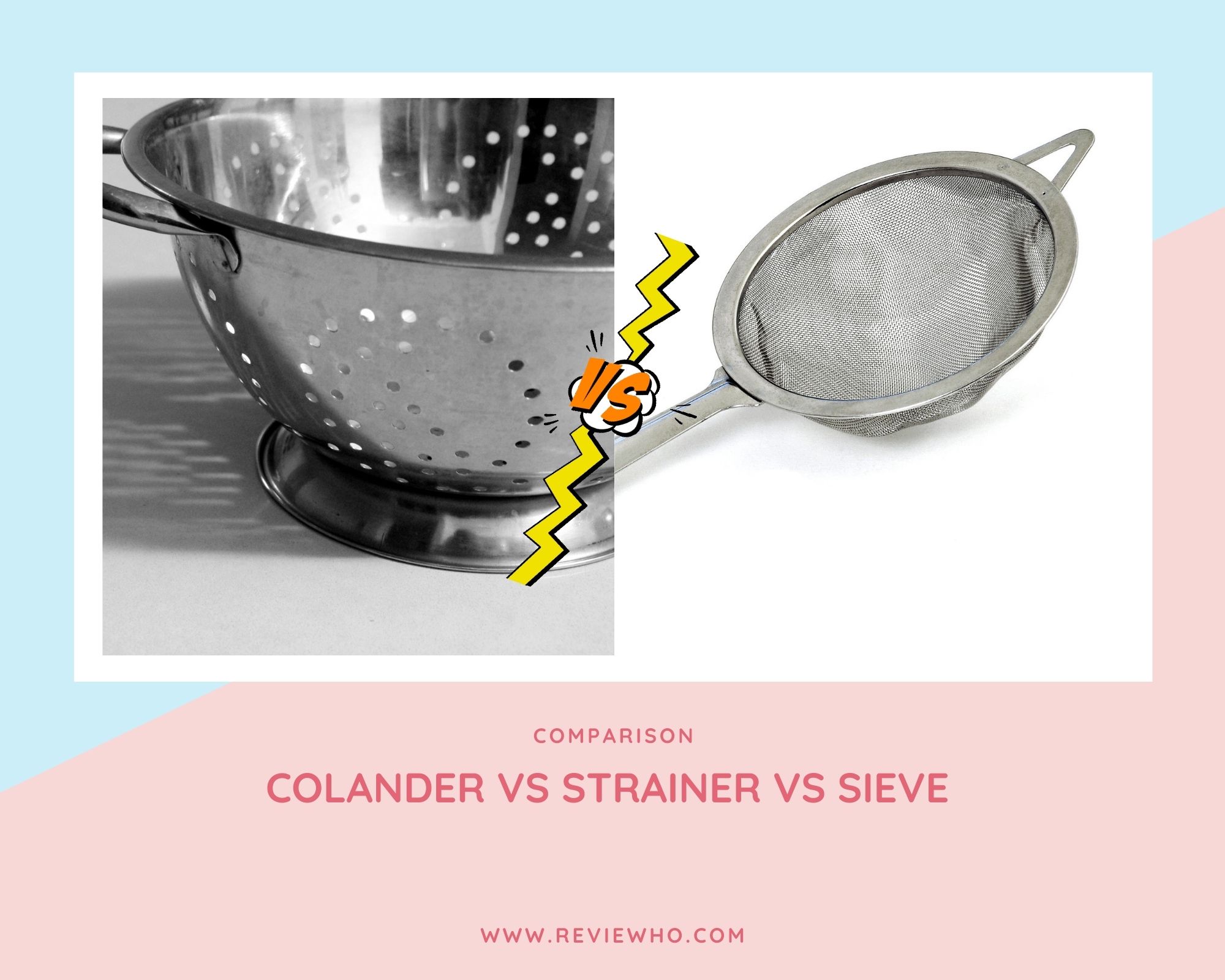The most common kitchen utensil you will find for the separation of solids from liquids is a sieve. Separating some seeds from juice or tea is one of the main tasks you will find yourself facing in the kitchen. However, did you know that three distinct utensils would seem to be made for the same tasks but are not? Well, there are colanders, sieves, and strainers. All of these are different in certain ways, including their functionality. In this post, we aim to shed some light on any similarities or differences in the colander vs. strainer vs. sieve comparison.
We will start by looking at each item before making a comparison.
Colander

Imagine this. You purchase some vegetables from your local market for your dinner. Before you start cooking the vegetables, you will have to clean them to remove all dust and dirt. What you would need for this task, is a colander. A colander is a deep bowl with holes on its sides.
The holes on a colander make sure that the water will keep on draining out as your vegetables become cleaner. You can easily identify a colander because it is deep, usually made using steel. Apart from the holes on the side, you will notice that it has handles to hold so that you can make work easier.
The current market has colanders made using all sorts of materials including ceramic, aluminum, as well as plastic. When you are washing meat or some fresh chicken underwater for the removal of blood, this utensil will prove invaluable.
Strainer

This is a general term that is used to generalize tools that help in draining liquids from solids. Think about it this way, you have cooked pasta and you need to separate the pasta from the water. Using your hands would be very risky and it is somehow unhygienic. So, you would have more success if you used a strainer. You will remove all the excess water and you will not touch your pasta at any point.
If you are trying to make some lemon juice, you would require a strainer to help you remove the seeds from the juice.
Strainers are available with different sizes of mesh. You can choose a coarse or fine mesh, although it will depend on what you need.
Stainless steel strainers are the most common in the world.
Sieves

A sieve, also known as a sifter, is made using wire mesh and features a single long handle. You will find some improved ones that feature a loop or a hook that will sit on a bowl or pot’s rim so that collection of the strained liquid can be easier. A sieve’s bowl is usually cone-shaped, or round.
A sieve can be fine or coarse meshed. A coarse-meshed sieve is very important for most of your daily tasks such as staining small stock amounts, as well as sifting flour and other similar ingredients.
A fine-meshed sieve comes in handy when you are preparing a refined sauce so that it eliminates any possible graininess or lumps. You can also use one to prepare smooth purees.
The best sieve in the market is the Chinois, a French conical-shaped sieve that has two layers of fine mesh. It can withstand the pressure exerted by a wooden spoon that forces solids through.
Differences
Sieve vs. Colander
So, do you need a sieve or colander for the task at hand? Let’s compare the two.
Sieves and colanders are all referred to as strainers. Nevertheless, they have different tasks. You use a colander for draining water from a liquid. That means that you would use it when you want to discard a liquid such as water from the pasta to dry the pasta. A sieve, on the other hand, is used to save liquids such as broth or cooking oil for stock.
A colander features a wide bowl, usually accompanied by two handles. The base also has feet so that it can stand by itself in a sink while you pour some boiled vegetables or pasta in it. Most are made from porcelain, aluminum, stainless steel, as well as plastic. In most cases, colanders are similar to bowls that have holes all over, although you will find some models that are made using mesh. A more functional one will have more holes at the bottom than the top.
A sieve does not stand by itself. Instead, it is placed on a bowl or a pot in which the liquid being saved will go. A sieve is only made using mesh.
Sieve vs. Strainer
Both these tools are commonly confused with each other, mainly because they function the same way. But what are the main sifter vs. strainer differences?
Well, when you use a sifter, clumps or coarse particles will be broken up or separated after grinding against other particles and the mesh.
A strainer has the same basic functionality as a perforated screen, which can easily be a cloth or a screen. It is mainly used to separate any solid from a liquid.
These two have the same technique even though the outcome might vary depending on the type of food you use on the sieve.
The sieve vs. strainer difference is that the sieve will sift powder and no food particles will be left on the mesh. On the other hand, a strainer will have remnants on the screen and the liquid passes.
Do you need both a sieve and strainer? The answer will depend on if you bake a lot. A strainer is very important in a kitchen. A sifter is only necessary if you bake a lot and would need a sifted ingredient.
Conclusion
To be honest, you do not need to choose one tool or another. All of these tools are readily available in different marketplaces. They are also available at affordable prices. We recommend that you go to the market, find one of each, and add them to your kitchen. If you need one for a specific task, you will have it in the kitchen.
Here are a few hand-picked guides for you to read next:
Feel free to share your observations with me in the comments section!
Also, if you find the information in this post to be useful, be sure to share this post with your friends on Facebook, Twitter, and Pinterest!




